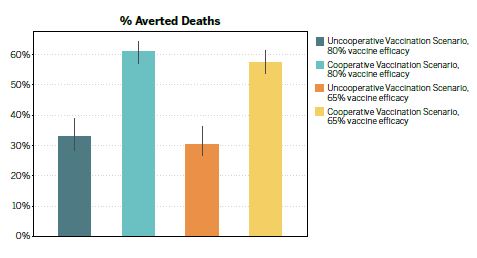UF professor Ira Longini, Ph.D., recently contributed to a modeling study that estimates the effectiveness of two different global distribution strategies for a hypothetical COVID-19 vaccine. In one scenario, countries work together, and in the other wealthy countries focus only on their own citizens.
Longini is a professor in the department of biostatistics in the UF College of Public Health and Health Professions and the UF College of Medicine. He is a renowned expert in designing vaccine trials and vaccination strategies, as well as modeling infectious disease transmission; he works frequently with the World Health Organization and the US Centers for Disease Prevention and Control.
The new study was led by researchers at Northeastern University’s Laboratory for the Modeling of Biological and Socio-technical Systems (also known as the MOBS Lab). It is not yet peer-reviewed but is available online as a pre-print. The study results are also featured in the Gates Foundation 2020 Goalkeepers Report: COVID-19 A Global Response.
The research team analyzed what would happen if countries either cooperated or were selfish when distributing 3 billion doses of a hypothetical COVID-19 vaccine across the world. In the cooperative scenario, the doses are distributed proportional to each countries’ population. In the selfish scenario, the wealthiest countries snap up the first 2 billion doses for their own citizens.
The model assumes that the vaccine is effective after two weeks. But because no one knows what the future course of the pandemic may be, the researchers ran simulations assuming that a vaccine was available on March 16, 2020 and they analyzed how its availability and allocation would have affected the approximately 900,000 COVID-19 deaths recorded globally by September 1. By simulating “what if” scenarios, the researchers compared the effectiveness of the two allocation strategies against what unfolded in reality when no vaccine was available.

Their model showed that if nations were to cooperate to distribute a vaccine with 80% efficacy, it would have reduced actual COVID-19 related deaths by 61%, while the selfish scenario would have averted only 33% of these deaths. (See graph above.) When the vaccine’s efficacy was lowered to 65%, the model estimates that the cooperative and selfish allocation strategies would have resulted in 57% and 30% fewer deaths, respectively.
The research shows that when nations cooperate to distribute a vaccine, they can save far more lives globally than if wealthy nations were to focus only on their own citizens.
This story was originally posted on EPI UF.
Check out more stories about UF research on COVID-19.

